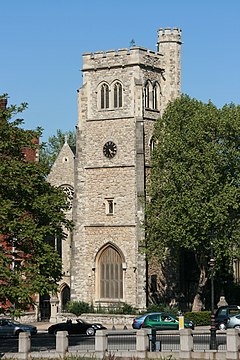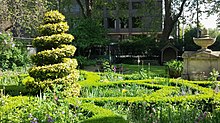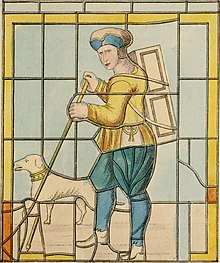

The Garden Museum (formerly known as the Museum of Garden History) in London is Britain's only museum of the art, history and design of gardens. The museum re-opened in 2017 after an 18-month redevelopment project.
The building is largely the Victorian reconstruction of the Church of St Mary-at-Lambeth which was deconsecrated in 1972 and was scheduled to be demolished. It is adjacent to Lambeth Palace on the south bank of the River Thames in London, on Lambeth Road. In 1976, John and Rosemary Nicholson traced the tomb of the two 17th-century royal gardeners and plant hunters John Tradescant the Elder and the Younger to the churchyard, and were inspired to create the Museum of Garden History. It was the first museum in the world dedicated to the history of gardening.
The Museum's main gallery is on the first floor, in the body of the church. The collection includes tools, art, and ephemera of gardening, including a gallery about garden design and the evolution of gardening, as well as a recreation of Tradescant's 17th-century Ark. The collections give an insight into the social history of gardening as well as the practical aspects of the subject. There are three temporary exhibition spaces which look at various aspects of plants and gardens and change every six months The redevelopment of the Museum, completed in 2017, included two new garden designs. The Sackler Garden, designed by Dan Pearson sits at the centre of the courtyard, replacing the knot garden, and the Museum's front garden is designed by Christopher Bradley-Hole.
In 2006, Christopher Woodward, formerly director of the Holburne Museum in Bath, Somerset, was appointed as the director of the Garden Museum.
Development of the museum

The museum is run as an independent registered charity and does not receive government funding, instead depending on Friends, Patrons and charitable trusts, in addition to income from admission and events. In 2002, its 25th anniversary year, the museum launched a campaign to raise at least £600,000 to pay for a general overhaul of its facilities.
Phase I (2008)
Following a design competition, in 2008, the museum's interior was transformed into a centre for exhibitions and events by the construction of contemporary gallery spaces; the work was designed by Dow Jones Architects. The renamed museum (now the Garden Museum) opened to the public on 18 November of that year.
Phase II (2015–2017)
From 2015 to 2017, the Museum undertook a second phase of work to complete the restoration of the ancient structure and its transformation into a museum. In 2014 the museum was awarded a grant of £3,510,600 from the Heritage Lottery Fund for the development. The redeveloped museum re-opened in 2017 with more galleries and spaces for education and events inserted into the historic interior in a second, award-winning design by Dow Jones Architects.
This phase doubled the space for display of the permanent collection, 95% of which was in store, and created extra space for schools and community outreach work, in addition to a bigger café and modern visitor services. At the core of the project was an aspiration to create the country's first archive of garden and landscape design which is open to the public on appointment. The museum now includes a recreation of "Tradescant's Ark" through the loan from the Ashmolean Museum of the objects which originally belonged in Tradescant's collection at Lambeth, later bequeathed to his neighbour, Elias Ashmole.
The redevelopment also included a viewing platform being lowered onto the medieval tower, allowing the public to access the tower and enjoy the view across the Thames to Westminster for the first time.
In 2020, Dan Pearson designed a new courtyard garden for Garden Museum; his inspiration for this garden came from a number of people who might be considered the modern-day equivalents of the Tradescants.
St Mary-at-Lambeth

The Garden Museum is housed in the medieval and Victorian church of St Mary-at-Lambeth. The first church on the site was built before the Norman Conquest, and was integral to the religious centre established by the Archbishops of Canterbury in the 12th century. The structure was deconsecrated in 1972, and rescued from demolition by the museum's founder, Rosemary Nicholson. The museum opened in 1977 as the world's first museum of garden history; the churchyard was re-designed as a garden.
The church is the oldest structure in the London Borough of Lambeth, except for the crypt of Lambeth Palace itself, and its burials and monuments are a record of 950 years of a community. But for the Palace, it has perhaps the richest historical story of any building in the borough.
In 1062, a wooden church was built on the site by Goda, sister of Edward the Confessor; the Domesday Book of 1086 records 29 tenancies in her manor. Later in the century, it was rebuilt as a stone church and appears to have been at its height of splendour and patronage in the twelfth century, when it functioned as the church to the Archbishops' London lodgings next door.
In 1377, the stone tower was built; it was repaired in 1834–1835, but is otherwise intact and visitors can climb the tower for views across London. The body of the church was continually rebuilt and enriched over the centuries but, decisively, in 1851–1852 the aisles and nave were rebuilt by Philip Charles Hardwick, an architect prominent in the construction of banks and railway stations but not considered to be in the "first rank" of his generation; his father, Sir Philip Hardwick, designed the Euston Arch. It is described by Museum of London Archaeology Service "as an almost complete rebuilding of the old body of the church". The most eye-catching survivals are four of eight corbels in the ceiling of the nave. These are a mix of medieval and Victorian construction.
One of the few 20th-century interventions in the church's fabric took place in around 1900, with the insertion of an immersion font and a baptistery at the base of the tower, said to be one of only two examples in Anglican churches in England.

During the Second World War, the stained glass was badly damaged by bombs and, in the 1950s, the stained glass was replaced by either plain glass or panels by Francis Stephens (1921–2002), including a replica of the "Pedlar's Window". The bombs also broke up the altar donated in 1888 by Sir Henry Doulton as a memorial to his wife; Doulton's ceramic factory stood about 300 yards to the south.
In 1972, the church was made redundant due to its dilapidation and gloom, and also because of changes in the population settlement of the parish: the area by the riverside had become derelict and under-populated, and the vicar wanted a church closer to where the congregation lived. In 1969, Lambeth Council designated the area around Lambeth Palace as one of the borough's first conservation areas.
Soon after the Church Commissioners obtained the necessary consents for demolition, the altar, bells and pews were removed. In 1976, Rosemary Nicholson visited the site to see the tomb of John Tradescant and was shocked to discover the church boarded up in readiness for its demolition. She established the Tradescant Trust, which was awarded a 99-year lease from the Diocese of Southwark, who continue to own the land. The trust's rescue and repair of the structure became one of the great architectural conservation causes of its time, and the church became a museum.
St Mary's churchyard and burials
The church was a place of burial until the churchyard was closed in 1854, and the ground level of the site has risen in consequence. It is estimated that there are over 26,000 burials. The prestige of the site is reflected in the wills of many citizens who ordered tombs for themselves, particularly in the chancel. The most significant of these is the chantry tomb on its north wall of Hugh Peyntwyn (died 1504), which is the earliest known example of a new design of wall monument associated with the royal workshops. Opposite is a monument of the same type to John Mompesson (died 1524). The Garden Museum is unique in having two monuments of this type.
The church originally housed the 15th- and 16th-century tombs of many members of the Howard family, including now-lost memorial brasses to Thomas Howard, 2nd Duke of Norfolk (died 1524) and his wife Agnes Howard, Duchess of Norfolk (died 1545), and is also the burial place of Anne Boleyn's mother, Elizabeth Boleyn (died 1538), formerly Howard. Elias Ashmole (instrumental in the development of speculative freemasonry and founder of the Ashmolean Museum at Oxford) was buried in the church in 1692. Later burials inside the church includes the soprano Nancy Storace.
Burials outside in the churchyard include John Sealy of the Coade Stone Manufactory and Vice-Admiral Bligh of HMS Bounty fame. The churchyard is exceptional for having Grade II* listed tombs (those of Tradescant, Sealy and Bligh). Lambeth expanded quickly in the 19th century and 15,900 burials are recorded in the two decades after 1790. The churchyard was enlarged in 1814 but was closed in 1854, at a time when other city churchyards were closed by Act of Parliament.
Tomb of the Tradescants


Five members of the Tradescant family are buried here: John Tradescant the Elder; John Tradescant the Younger with his two wives Jane and Hester, and his son, also called John, who died aged 19. The original 17th-century design for the tomb is in the Pepys Library, Cambridge, and an image of it may also be found at the National Portrait Gallery.
The present tomb is the third on the site of the Tradescant grave and replicates the original design. It was restored by public subscription in 1853.
On the east side of the tomb is carved the family arms, on the west side a skull and a seven-headed hydra, on the south side broken columns, Corinthian capitals, a pyramid and ruins, and on the north side shells, a crocodile, and a view of some Egyptian buildings.
The epitaph on the top of the tomb was written by Tradescant's friend, John Aubrey (spelling modernised):
- Know, stranger, ere thou pass, beneath this stone
- Lie John Tradescant, grandsire, father, son
- The last dy'd in his spring, the other two,
- Liv'd till they had travelled Art and Nature through,
- As by their choice Collections may appear,
- Of what is rare in land, in sea, in air,
- Whilst they (as Homer's Iliad in a nut)
- A world of wonders in one closet shut,
- These famous Antiquarians that had been
- Both Gardeners to the Rose and Lily Queen,
- Transplanted now themselves, sleep here & when
- Angels shall with their trumpets waken men,
- And fire shall purge the world, these three shall rise
- And change this Garden then for Paradise.
Local Lambeth legend states that if the tomb is danced around twelve times, while Big Ben strikes midnight, a ghost appears.
Coffins found during redevelopment
During renovation works in 2016, workers uncovered a vault containing 30 coffins, including those of five Archbishops of Canterbury. These included: Richard Bancroft (who oversaw the production of the King James Bible), John Moore, Frederick Cornwallis, Matthew Hutton and Thomas Tenison. Further identified burials were Catherine Moore, wife of John Moore, and John Bettesworth, a Dean of Arches.
References
- "Garden Museum opening hours". Garden Museum. Retrieved 22 September 2016.
- "Lost churches" (PDF). Diocese of Southwark. Archived from the original (PDF) on 17 February 2017. Retrieved 22 September 2016.
- ^ Tradescant Trust (1979) The Tradescant Story (London).
- ^ "Museum". Garden Museum. Retrieved 1 August 2017.
- "Exhibitions – Garden Museum". Garden Museum. Retrieved 1 August 2017.
- "Garden Museum, registered charity no. 1088221". Charity Commission for England and Wales.
- "Garden Museum / Dow Jones Architects". ArchDaily. 19 January 2009. Retrieved 21 July 2023.
- "Development Update". Garden Museum. Archived from the original on 17 February 2017. Retrieved 22 September 2016.
- "Garden Museum awarded grant". Heritage Lottery Fund. Archived from the original on 24 November 2018. Retrieved 22 September 2016.
- "Development Project". Garden Museum. Retrieved 1 August 2017.
- "Tradescant Collection". Ashmolean Museum. Retrieved 22 September 2016.
- "Garden Museum – Medieval Tower". Vimeo. Retrieved 2 August 2017.
- "The Garden Museum's Dan Pearson courtyard garden". Gardens Illustrated. 10 March 2020. Retrieved 27 June 2021.
- ^ "St Mary-at-Lambeth". Garden Museum. Retrieved 1 August 2017.
- Survey of London: Volume 23, Lambeth: South Bank and Vauxhall. London County Council, London. 1951. pp. 104–117.
- Webster, Nesta Helen (1924). Secret Societies and Subversive Movements. London: Boswell. p. 122.
- ^ Jennifer., Potter (2008). Strange Blooms : the Curious Lives and Adventures of the John Tradescants. Chicago: Atlantic Books. ISBN 9781843543350. OCLC 895432142.
- "Person – National Portrait Gallery". Retrieved 2 August 2017.
- writer), Clark, James (Freelance (2013). Haunted Lambeth. Stroud: History. ISBN 9780752485775. OCLC 813858096.
{{cite book}}: CS1 maint: multiple names: authors list (link) - "Remains of five 'lost' Archbishops of Canterbury found". BBC News. 16 April 2017. Retrieved 16 April 2017.
- Brinkhurst-Cuff, Charlie (16 April 2017). "Remains of five archbishops found near Lambeth Palace". The Guardian. Retrieved 16 April 2017.
- "Secret hole in London museum floor reveals stairs to hidden tomb of five archbishops". The Independent. 16 April 2017.
External links
 Media related to Garden Museum at Wikimedia Commons
Media related to Garden Museum at Wikimedia Commons- Official website

- Events and Temporary Exhibitions at the Garden Museum
- Obituary of Rosemary Nicholson, foundress of the Museum, 26 November 2004, Telegraph
- Church of St Mary, Lambeth entry at the Survey of London
| Churches in Lambeth | |||
|---|---|---|---|
| Ancient parish churches (pre-1800) |
| ||
| Anglican daughter churches | |||
| Other denominations | |||
51°29′42″N 0°07′13″W / 51.4950°N 0.1202°W / 51.4950; -0.1202
Categories:- 1977 establishments in England
- Museums established in 1977
- Museums in the London Borough of Lambeth
- Garden museums
- History museums in London
- Gardening in the United Kingdom
- Churches in the London Borough of Lambeth
- Former churches in London
- Former Church of England church buildings
- Parks and open spaces in the London Borough of Lambeth
- History of the London Borough of Lambeth
- Charities based in England
- Horticultural organisations based in the United Kingdom
- Grade II* listed buildings in the London Borough of Lambeth
- Open-air museums in England


